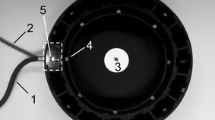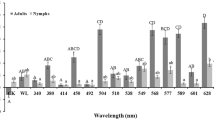Abstract
Responses of adult Indianmeal moth, Plodia interpunctella (Hübner) (Lepidoptera: Pyralidae) to light alone and to a combination of attractant(s) and green/UV lights were studied. When P. interpunctella adults were given a choice between dark areas and areas illuminated with UV, green, or white light, they rested preferentially on surfaces in the illuminated areas. UV light elicited the strongest of the positive phototactic responses. Light traps were not as effective as traps baited with pheromones or food lures in capturing adult moths, and combining green or UV light with these attractants did not significantly increase the trap catches. Gravid females required a period of darkness to realize maximum oviposition, and illumination above 8 lx during the scotophase of a 24-hr light–dark cycle inhibited oviposition.







Similar content being viewed by others
References
Antignus Y (2000) Manipulation of wavelength-dependent behaviour of insects: an IPM tool to impede insects and restrict epidemics of insect-borne viruses. Virus Res 71:213–220
Barr AR, Smith TA, Boreham M, White KE (1963) Evaluation of some factors affecting the efficiency of light traps for collecting mosquitoes. J Econ Entomol 56:123–127
Bell CH (1981) The influence of light cycle and the circadian rhythm on oviposition in five pyralid moth pests of stored products. Physiol Entomol 6:231–239
Briscoe AD, Chittka L (2001) The evolution of color vision in insects. Annu Rev Entomol 47:471–510
Bruce WA, Lum PTM (1976) UV radiation: effect on synthetic sex pheromone of the Indian meal moth. Fla Entomol 59:53–54
Bruce WA, Lum PTM (1981) Insect pheromone protection from degradation by ultraviolet radiation. J Ga Entomol Soc 16:227–231
Burkett DA, Butler JF, Kline DL (1998) Field evaluation of colored light emitting diodes as attractants for woodland mosquitoes and other Diptera in north central Florida. J Am Mosq Cont Assoc 14:186–195
Callahan PS (1957) Oviposition response of the imago of the corn earworm, Heliothis zea (Boddie), to various wavelengths of light. Ann Entomol Soc Am 50:444–452
Cox PD, Bell CH (1991) Biology and ecology of moth pests of stored foods. In: Gorham JR (ed) Ecology and management of food-industry pests. Association of Official Analytical Chemists, Arlington, VA, pp 181–193
Dreisig H (1980) The importance of illumination level in the daily onset of flight activity in nocturnal moths. Physiol Entomol 5:327–342
Frisch KV (1967) The dance language and orientation of bees. Harvard University Press, Cambridge, Massachusetts
Gilbert D (1984) Insect electrocutor light traps. In: Baur FJ (ed) Insect management for food storage and processing, 1st edn. American Association of Cereal Chemists, St. Paul, MN, pp 87–108
Hagstrum DW, Tomblin CF (1973) Oviposition by the almond moth, Cadra cautella, in response to falling temperature and onset of darkness. Ann Entomol Soc Am 66:809–812
Henneberry TJ, Howland AF (1966) Response of male cabbage loppers to black light with or without the presence of female sex pheromone. J Econ Entomol 59:623–626
Henneberry TJ, Howland AF, Wolf WW (1967) Combinations of blacklight and virgin females as attractants to cabbage looper moths. J Econ Entomol 60:152–156
Kirkpatrick RL, Yancey DL, Marzke FO (1970) Effectiveness of green and ultraviolet light in attracting stored-product insects to traps. J Econ Entomol 63:1853–1855
Labhart T (1974) Behavioral analysis of light intensity discrimination and spectral sensitivity in the honey bee, Apis mellifera. J Comp Physiol A 95:203–216
LeCato GL (1976) Yield, development, and weight of Cadra cautella (Walker) and Plodia interpunctella (Hübner) on twenty one diets derived from natural products. J Stored Prod Res 12:43–47
Lum PTM, Flaherty BR (1970) Regulating oviposition by Plodia interpunctella in laboratory by light and dark conditions. J Econ Entomol 63:236–239
Madrid FJ, Sinha RN (1982) Movement and oviposition of Ephestia cautella (Walker) and Plodia interpunctella (Hübner) (Lepidoptera: Pyralidae) of different ages in response to seasonal light changes. Can J Zool 61:1726–1732
Marzke FO, Street MW, Mullen MA, McCray TL (1973) Spectral responses of six species of stored-product insects to visible light. J Ga Entomol Soc 8:195–200
Mason L (2003) Insects and mites. In: Hui YH, Bruinsma BL, Gorham JR, Nip WK, Tong PS, Ventresca P (eds) Food plant sanitation. Marcel Dekker, New York, pp 293–315
Mbata GN (1985) Some physical and biological factors affecting oviposition by Plodia interpunctella (Hubner) (Lepidoptera: Phycitidae). Insect Sci Applic 6:597–604
Na HJ, Ryoo MI (2000) The influence of temperature on development of Plodia interpunctella (Lepidoptera: Pyralidae) on dried vegetable commodities. J Stored Prod Res 36:125–129
Payton ME, Richter SJ, Giles KL, Royer TA (2006) Transformations of count data for tests of interaction in factorial and split-plot experiments. J Econ Entomol 99:1002–1006
Perez-Mendoza J, Aguilera-Peña M (2004) Development, reproduction, and control of the Indian meal moth, Plodia interpunctella (Hübner) (Lepidoptera: Pyralidae), in stored seed garlic in Mexico. J Stored Prod Res 40:409–421
Phillips TW (2006) The science and technology of postharvest insect control: challenges, accomplishments and future directions. In: Heaps JW (ed) Insect management for food storage and processing, 2nd edn. American Association of Cereal Chemists, St. Paul, MN, pp 211–222
Phillips TW, Strand MR (1994) Larval secretions and food odors affect orientation in female Plodia interpunctella. Entomol Exp Appl 71:185–192
Prokopy RJ, Owens ED (1983) Visual detection of plants by herbivorous insects. Annu Rev Entomol 28:337–364
Rizk GA, Soliman MA, Ishmael HM (1990) Efficiency of sex pheromone and UV light traps attracting male moths of the cotton leafworm, Spodoptera littoralis (Boisd.). Assiut J Agric Sci 21:86–102
SAS Institute (2003) The SAS system version 9.1 for Windows. SAS Institute Inc., Cary, NC
Sauer JA, Shelton MD (2002) High-temperature controlled atmosphere for post-harvest control of Indian meal moth (Lepidoptera: Pyralidae) on preserved flowers. J Econ Entomol 95:1074–1078
Scherer C, Kolb G (1987a) Behavioral experiments on visual processing of color stimuli in Pieris brassicae L. (Lepidoptera). J Comp Physiol A 160:645–656
Scherer C, Kolb G (1987b) The influence of color stimuli on visually controlled behavior in Aglais urticae L. and Parage aegeria L. (Lepidoptera). J Comp Physiol A 161:891–898
Silberglied RE (1979) Communication in the ultraviolet. Annu Rev Ecol Syst 10:373–398
Soderstrom EL (1970a) Effectiveness of green electroluminescent lamps for attracting stored-product insects. J Econ Entomol 63:726–731
Soderstrom EL (1970b) Phototactic responses of stored-product insects to various intensities of ultra-violet light. J Stored Prod Res 6:275–277
Stair R, Johnston R (1953) Ultraviolet spectral radiant energy reflected from the moon. J Res Nat Bureau Stan 51:81–84
Stalleicken J, Labhart T, Mouritsen H (2006) Physiological characterization of the compound eye in monarch butterflies with focus on the dorsal rim area. J Comp Physiol A 192:321–331
Stavenga DG (1992) Eye regionalization and spectral tuning of retinal pigments in insects. Trends Neurosci 15:213–218
Steele RW (1970) Copulation and oviposition behavior of Ephestia cautella (Walker) (Lepidoptera: Phycitidae). J Stored Prod Res 6:229–245
Stermer RA (1959) Spectral response of certain stored-product insects to electromagnetic radiation. J Econ Entomol 52:888–892
USDA (1975) Insects on dried fruits, agriculture handbook 464. United States Department of Agriculture, Washington, DC
White RH, Xu H, Münch TA, Bennett RR, Grable EA (2003) The retina of Manduca sexta: rhodopsin expression, the mosaic of green,-, blue-, and UV-sensitive photoreceptors, and regional specialization. J Exp Biol 206:3337–3348
Zar JH (1999) Biostatistical analysis, 4th edn. Prentice-Hall, Upper Saddle River, New Jersey
Acknowledgements
We thank Drs. Tom Royer and Rizana Mahroof for reviewing an earlier draft of this manuscript. We are grateful to Dr. Mark Payton, Department of Statistics, Oklahoma State University, for his helpful suggestions regarding data analyses. Randy Beeby helped during conduct of experiments in the metal sheds. This work was funded by a grant from the USDA-CSREES Risk Avoidance and Mitigation Program, and was approved for publication by the Oklahoma Agricultural Experiment Station.
Author information
Authors and Affiliations
Corresponding author
Rights and permissions
About this article
Cite this article
Sambaraju, K.R., Phillips, T.W. Responses of Adult Plodia interpunctella (Hübner) (Lepidoptera: Pyralidae) to Light and Combinations of Attractants and Light. J Insect Behav 21, 422–439 (2008). https://doi.org/10.1007/s10905-008-9140-5
Revised:
Accepted:
Published:
Issue Date:
DOI: https://doi.org/10.1007/s10905-008-9140-5




